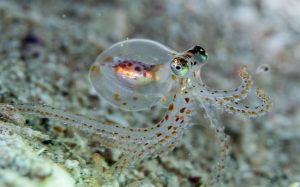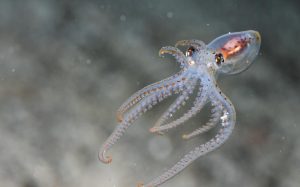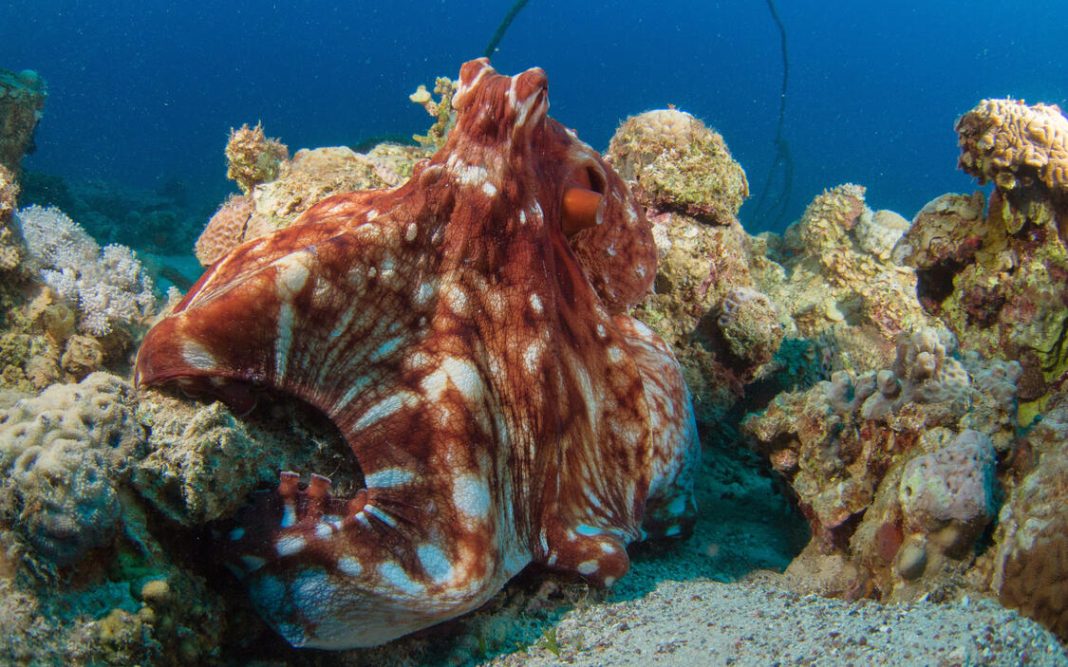Meeting an octopus is, in many respects, the closest we can come to meeting interplanetary aliens. Yet, new research shows their brains have some startling commonalities to those of humans—perhaps most notably in terms of microRNA (miRNA) and the role it plays in brain development. miRNA may be crucial for the development of complex brains.
“Complex brains with higher cognitive features have only evolved in vertebrates…with one exception: soft body cephalopods, for example octopuses,” notes Nikolaus Rajewsky, PhD, scientific director of the Berlin Institute for Medical Systems Biology of the Max Delbrück Center (MDC-BIMSB), and head of the systems biology of gene regulatory elements lab. “This is important because the octopus brain has evolved completely independently from the complex mammalian brain.”
Rajewsky began his research after reading scientific literature noting that octopuses are adept at RNA editing. He hypothesized that perhaps the octopus is therefore an “RNA-artist” and has evolved other RNA-based mechanisms. “Those mechanisms would be interesting to identify—not only to understand octopus evolution better but also to potentially harness new tools for RNA applications in humans,” Rajewsky says.
He profiled messenger RNAs, noncoding RNAs and, specifically, small RNAs in18 different tissue types from deceased octopuses. While RNA editing turned out to be less interesting because editing sites did not map to important sites, the researchers discovered 42 novel miRNA families in neural tissue—primarily in the brain.

The 42 miRNA families Rajewsky and his team identified are not shared with humans. In fact, the most recent common ancestor of octopuses and humans was a primitive flatworm that lived approximately 750 million years ago. These genes were conserved during the evolution of the octopus, so they are likely to be beneficial. Now the question is exactly what benefits they provide.
Another style of intelligence
Octopuses are curious creatures possessing an inventive mindset exemplified by their ability to disguise and protect themselves using opened shells for protection or as projectiles and to gather and store them for later use, as well as their well-known camouflage abilities. They also remember people and things and have distinct preferences. A team of Brazilian researchers thinks they may even dream.
Some researchers have reported they aren’t motivated by snacks (like other animals). As Rajewsky points out, “They do have personalities, so—just maybe—they realize you’re trying to reward them with food and don’t like to be manipulated. I’m not a behavioral scientist. I’m just speculating,” he stresses, “but it does account for the fact that there’s intelligence there that you cannot right away compare with our concepts.
“The octopus is a special invertebrate. By studying how the brain functions in octopuses, we can maybe learn new tools to interfere with our nervous systems or to understand our nervous system better,” Rajewsky tells GEN. While researchers are clearly interested in studying this animal, it’s not in danger of becoming the next lab rat. Its brain is “the most distant brain of all other animal brains.”
Octopuses also are difficult to study, needing aquariums. Rajewsky is a systems biologist working in molecular biology to understand the functioning of cells in tissues, as well as diseases, by studying molecular interactions. “To do this in the octopus, I can only do descriptive studies. I cannot do molecular experiments in octopuses because I don’t have tanks with animals.” It also would require adjusting the existing tools to octopus biochemistry. Therefore, he says, “I’m not intending to experiment on octopuses.” Instead, he analyzes frozen tissue samples collected from a marine station in Naples.
Finding the evolutionary departure
Rajewsky and his team began by quantifying major modes of posttranscriptional regulation across the 18 octopus tissues. They found that A-to-I editing was separate from the miRNA function, and therefore did not modulate it in any functionally important regard. Specifically, “…most of that editing occurred in the introns and 3 prime UTRs of mRNAs,” they wrote, with alternative splicing highest in neural tissues, as expected. Editing rarely altered the splice sites. The transcriptome, in fact, generally resembled that of other invertebrates.
The major evolutionary departure of the octopus from other invertebrates became evident when the researchers investigated miRNAs, they knew bound to the 3’ untranslated regions (3’UTRs).
The octopus genome has 138 miRNA families. When miRNA from Octopus vulgaris was compared with that of another species, O. bimaculoides, which last shared a common ancestor approximately 50 million years ago, the researchers found 43 novel miRNA families were shared among the two octopus species and squid. (Research also shows that 12 miRNAs are shared between squid and nautilus, and another 35 miRNAs are restricted to the octopus lineage.)

The paper notes that these miRNA sites are conserved throughout evolution and the researchers suggest conservation is the result of functional interaction between the miRNA and miRNA response elements in specific tissues.
Next research goals
There are three things Rajewsky says he wants to learn from this research:
- In which specific cell types the newly discovered miRNAs are active. To do this, “We’ve developed a method to quantify miRNAs’ single cells,” he says, making them visible at a molecular level.
- How the various type of neurons and other cells in the brain communicate with each other at a molecular level and how they’re organized. “For this we will perform spatial transcriptomics.”
- How organism-specific miRNAs relate to brain evolution and either differ or correlate function between the octopi and human brains. “We can do experiments in human organoids to study human-specific miRNAs,” to determine this, he says.
Going further, Rajewsky plans to form a network of other octopus scientists to exchange insights.
Rajewsky became fascinated with octopuses after a trip to California’s Monterey Bay Aquarium, becoming “mesmerized” by an octopus in one of the tanks. “I have the feeling that this is a special and intelligent mind…so I read about octopuses as a hobby. Then, three years ago, I read a paper saying octopuses have elevated levels of RNA editing—a mechanism exists in humans in which RNA molecules can be reprogrammed, thus changing the nucleotide sequence in the RNA.
“Suddenly, I thought, maybe the octopus is an RNA extremophile. If they do this editing, maybe they do other things at the nuclear RNA level, as well.” He then embarked on a project to better understand how “this amazing animal has evolved, maybe learn something fundamental about how complex brains evolve and also something cool about RNA.”
What he has learned opens the door to a deeper understanding of miRNA’s role in the development of complex brains. “That is something that has been hypothesized for a long time,” Rajewsky says, and now it is becoming clearer. “It probably says, also, that miRNA is doing something in the brain that we still don’t understand.”



